#Dinosaur Park Formation
Explore tagged Tumblr posts
Text
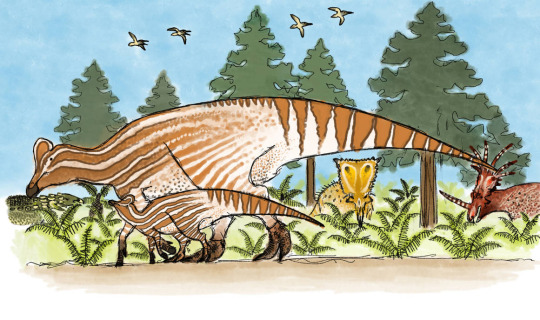
Mother and Son’s Day Out, Dinosaur Park Edition
#hypacrosaurus#hadrosaur#hadrosaurs#late cretaceous#campanian#ceratopsians#ceratopsian#chasmosaurus#styracosaurus#edmontonia#dinosaur park formation#cretaceous#paleoart#dinosaur#dinosaurs#paleontology#palaeontology#paleontology art#ornithischian#ornithopod#ornithischians#ornithischia#paleobiology#paleoblr#palaeoblr
484 notes
·
View notes
Text
Archovember 2024 Day 3 - Gorgosaurus libratus
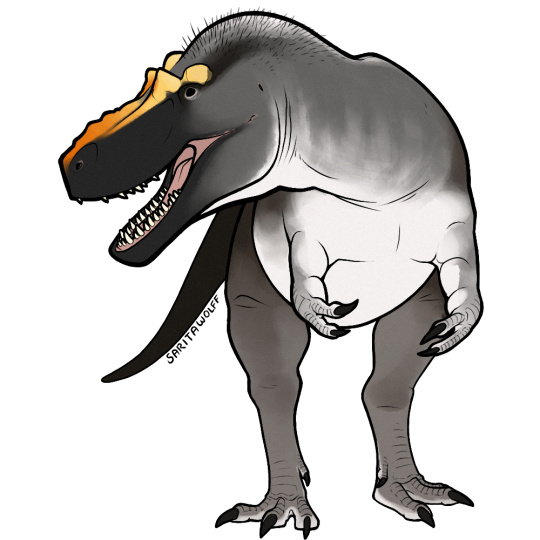
The apex predator of Western North America during the Late Cretaceous was Gorgosaurus libratus. Found so far in Alberta, Canada and Montana, USA, it lived several million years before Tyrannosaurus rex would appear. While it was a tyrannosaurid, it was more closely related to Albertosaurus, so much so that some scientists consider it to be another species of Albertosaurus. Gorgosaurus is the most numerous tyrannosaurid in the fossil record, known from dozens of specimens. This abundance of fossils has allowed paleontologists to investigate Gorgosaurus’ ontogeny, life history and many other aspects of its biology. For example, in 2023, a 5-7 year old juvenile Gorgosaurus was discovered with stomach contents consisting of two intact Citipes juveniles about a year old. This showed that younger Gorgosaurus’ were mostly eating prey much smaller than them, and were probably not hunting in packs, as the meal would not have been large enough to share. That being said, only the remains of the hindlimbs and caudal vertebrae of the juvenile Citipes were present, suggesting that this Gorgosaurus may have had a preference for the muscular hindlimbs. Many Gorgosaurus specimens also preserve evidence of facial scars, a result of intraspecies facebiting.
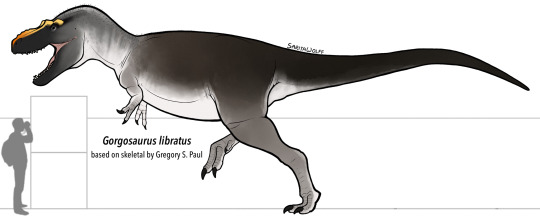
Gorgosaurus would have lived on the coastal plain along the western edge of the Western Interior Seaway, an inland sea which divided North America in half during the Late Cretaceous. The area was subtropical with periods of drought. Conifers would have dominated the forests, while the underbrush consisted of ferns, tree ferns and angiosperms. Gorgosaurus is best known from the Dinosaur Park Formation. Here, it would have lived alongside another apex predator: Daspletosaurus wilsoni. While these tyrannosaurids were roughly the same size, they may have preferred different types of prey, allowing them to coexist without too much competition. And there was a wide diversity of prey here, from many of the most famous ornithopods like Parasaurolophus walkeri, Corythosaurus casuarius, Gryposaurus notabilis, and Lambeosaurus lambei, to beloved ceratopsians like Styracosaurus albertensis, Centrosaurus apertus, Chasmosaurus belli, Spinops sternbergorum, and Vagaceratops irvinensis. There were also ankylosaurs like Anodontosaurus inceptus, Dyoplosaurus acutosquameus, Edmontonia rugosidens, Euoplocephalus tutus, Panoplosaurus mirus, Platypelta coombsi, and Scolosaurus. Pachycephalosaurids included Foraminacephale and Stegoceras validum. Gorgosaurus also shared space with other, smaller theropods, like the ornithomimids Ornithomimus and Rativates, caenagnathids like Caenagnathus, Chirostenotes, and Citipes, dromaeosaurids like Dromaeosaurus and Saurornitholestes, and troodontids like Latenivenatrix and Stenonychosaurus. Dinosaurs were not the only animals here, and Gorgosaurus would have also had to share space with the giant azhdarchid pterosaur Cryodrakon, as well as alligatoroids like Albertochampsa and Leidyosuchus, and choristoderes like Champsosaurus. Gorgosaurus is also known from the Two Medicine Formation and Judith River Formation.

This art may be used for educational purposes, with credit, but please contact me first for permission before using my art. I would like to know where and how it is being used. If you don’t have something to add that was not already addressed in this caption, please do not repost this art. Thank you!
#Gorgosaurus libratus#Gorgosaurus#tyrannosaurids#theropods#saurischians#dinosaurs#archosaurs#archosauromorphs#reptiles#Archovember#Archovember2024#Dinovember#Dinovember2024#DrawDinovember#DrawDinovember2024#SaritaDrawsPalaeo#Late Cretaceous#Canada#USA#Dinosaur Park Formation#Two Medicine Formation#Judith River Formation
119 notes
·
View notes
Text

Well, let's start this off with the thing in my profile pic. This is an older piece I done while I should have been paying attention to a class zoom call (~Feb-March 2021). The dinosaur that I intended to depict here is the enigmatic TMP 2002.76.1, more often referred to as the "Dinosaur Park Pachyrhinosaur" or "Iddesleigh Pachyrhinosaur." This fossil consists of a nearly complete skull and postcranium found at the very top of the Dinosaur Park Formation, and represents the earliest occurrence of a pachyrostran in the fossil record, roughly 500,000 years older than Achelousaurus and 1,000,000 years older than the earliest Pachyrhinosaurus proper. This specimen doesn't preserve the parietal portion of the frill and as such is difficult to resolve phylogenetically. It consistently groups in a polytomy with the previously mentioned genera, so it may belong to either of them or be a new taxon altogether. Interestingly the animal has pathological feet, with several of the phalanges of the hands and one foot showing stress fractures, resorption and destruction of distal elements, likely losing some of its toes.
For my part, I kind of dropped the ball on this one. I restored it as a kind of generic Pachyrhinosaurus. I like my work well enough on its own, but it doesn't really represent the fossil itself all too well. Mainly the area between the boss and beak, which I restored with two lateral scales more like in Pachyrhinosaurus canadensis, and the area between the nasal and supraorbital bosses which I made way too small. Additionally, though the frill is not known in TMP 2002.76.1 it probably wasn't the Pachyrhinosaurus frill I gave it.
I may revisit this in the future and give this fascinating fossil its proper due
The original description:
Ryan, M. J., et. al. (2008) A New Pachyrhinosaurus-Like Ceratopsid from the Upper dinosaur Park Formation (Late Campanian) of Southern Alberta, Canada. In M. J. Ryan, B. J. Chinnery-Allgeier, and D. A. Eberth, eds., New Perspective on Horned Dinosaurs: The Royal Tyrrell Museum Ceratopsian Symposium, pg. 141-155. Bloomington: Indiana University Press
The pathologies of the toes (pg. 372)
Tanke, D. H., Rothschild, B. M. (2008) Paleopathologies in Albertan Ceratopsids and Their Behavioral Significance. In M. J. Ryan, B. J. Chinnery-Allgeier, and D. A. Eberth, eds., New Perspective on Horned Dinosaurs: The Royal Tyrrell Museum Ceratopsian Symposium, pg. 355-384. Bloomington: Indiana University Press
#TMP 2002.76.1#digital art#dinosaurs#krita#ceratopsian#centrosaurine#pachyrostran#pachyrhinosaurus#achelousaurus#dinosaur park formation
5 notes
·
View notes
Text

The Beast has been defeated...
After a nearly month-long battle, I have bested this drawing! I rather enjoyed working on it even if I was concerned I wasn't going to finish in time.
38 characters and much fewer owners lol. All the character owners are listed here!
#artfight#artfight 2024#my art#team seafoam#dinosaur#dinosaur art#paleoart#dinosaur park formation#styracosaurus#parasaurolophus#dromeosaur#daspletosaurus#cryodrakon#fluvionectes#pachycephalosaurus#struthiomimus
10 notes
·
View notes
Text



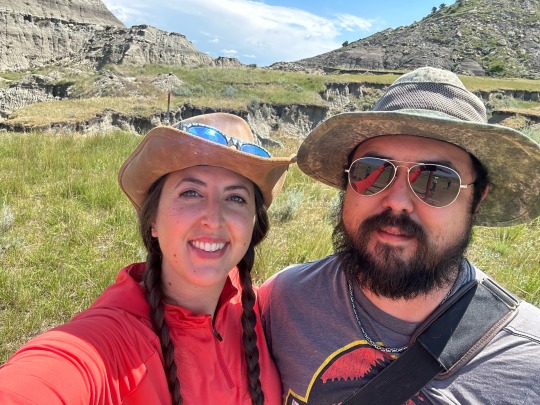
🦖 #7 on our top 10 favorite finds of the year: this fossilized tooth from a Hell Creek tyrannosaur!!! Yours truly lucked out seeing this tooth sticking out root-first from a hillside in Hell Creek formation, South Dakota. Our dino dig in July was a fabulous and informative experience, and digging fossils from the last dinosaurs to walk the earth during the Late Cretaceous period was so cool. With research throughout the year, we’ve settled on this tooth most likely being from a Nanotyrannus, a smaller species of tyrannosaur with some marked differences from its bigger cousin Rex. (Debate rages in the scientific community about whether this distinct species of tyrannosaur is valid, or if it’s all juvenile T.Rex fossils; contemporary dino diggers lean toward the validity of the separate species.)
Long before I knew about minerals, I dreamt about being a paleontologist (Jurassic Park kid!), so this was a lifelong dream coming true for me. We can’t wait to return to Hell Creek formation! 🦖 #toptenfindsof2024 #dinosaurs #nanotyrannus #nanotyrannustooth #dinosaurtooth #jurassicparkkid #jurassicpark #dinosaurfossils #cretaceousdinosaurs #hellcreek #hellcreekformation #southdakota #phenomenalgems
#phenomenalgems#hell creek formation#south dakota#dinosaur tooth#dinosaurs#bingo dino dna#tyrannosaurus rex#nanotyrannus#rock hounding#self collected#paleontology#late cretaceous#jurassic park
10 notes
·
View notes
Text
Fossil Friday: Utahraptor!

Remember this chimera? So, it may not be a real Velociraptor but there was a real dromaeosaur this size. It's called Utahraptor and it lived in, well, Utah during the early Cretaceous Period 135-130 million years ago.

It was found in the Cedar Mountain Formation near Moab in 1975 but it didn't get much recognition until 1991. There is currently a "Utahraptor block" that is in the process of being prepped out and has yielded remains of baby to adult Utahraptors (along with two iguanodontids).

Utahraptor is the state dinosaur of Utah and Utahraptor State Park was officially created in 2021 where the block was discovered.


18 notes
·
View notes
Text
Hell Creek is Real-World Jurassic Park
Jurassic Park features 7 very different dinosaurs throughout the film, Tyrannosaurus, Triceratops, Velociraptor, Brachiosaurus, Dilophosaurus, Gallimimus, and Parasaurolophus. Each animal being significantly different from the other.
What most of the animals have in common is having themselves or standin relatives (or generally standins) living in Hell Creek. For some, it's very obvious, for some, I have to take some very speculative leaps.

Homo sapiens -
No Homo sapiens in Hell Creek! I'm the reference here so, yeah. No humans. It would've been funny to include Purgatorius here but humans weren't cloned for Jurassic Park. Carry on.
Tyrannosaurus -
Tyrannosaurus rex is known from all across western North America, ranging from the south to north. It's range is especially large, and its most well known locality is Hell Creek.
The Tyrannosaurus specimen used was AMNH 5027, the same specimen Jurassic Park used for both its Tyrannosaurus design and its logo. With the in-film size being roughly around 4 meters tall and fairly large, it only somewhat outsizes the actual AMNH 5027 specimen, where the individual is rather 3.6 meters tall and 11.5 meters long.
Triceratops -
Triceratops is a very well known ceratopsian and is prominent across North America, but especially within Hell Creek. The species T. prorsus was intentionally chosen to have an emphasis on the nasal horn. The actual species basis of the film is not stated, but some can assume T. horridus was used only because of it being the type species.
Velociraptor (as Dakotaraptor) -
Dakotaraptor is a large dromaeosaur known from Hell Creek. A lot of its anatomy is highly controversial with it being a potential chimera (beyond the obvious confirmed for the mixed-in turtle material). Because of it, many things cannot be reliably inferred for how it looked and behaved. Some speculation of taking the leg and arm material seriously leads it to be a fairly tall and cursorial-built theropod, adapted for high speeds. The validity of this though is up in the air until more specimens are gathered.
Dakotaraptor was chosen as the standin for Velociraptor mongoliensis due to Jurassic Parks' interpretation of it being a human-height sprinter-type animal found within North America, similar to what potentially Dakotaraptor would've looked somewhat like and behaved.
Brachiosaurus (as Alamosaurus) -
Alamosaurus is a titanosaur that roamed across the North American Ojo Alamo Formation and some nearby locales. Its position in being a Hell Creek sauropod is disputed, with there being a megafaunal barrier between North-South, preventing sauropods like Alamosaurus venturing any further north into Hell Creek. Although some speculation of it venturing in occasionally at some point in history is somewhat likely.
Alamosaurus was chosen as the Brachiosaurus standin only due to it being the nearest North American sauropod to being a Hell Creek sauropod. Brachiosaurids died off in the middle Cretaceous as sauropods generally leaned to extremes of small or large.
Dilophosaurus (as Anzu) -
The biggest reach of this post is Dilophosaurus, since Dilophosaurus and its closest relatives died off in the early-middle Jurassic due to them being an intermediate tetanuran, rather than being part of a surviving lineage.
Anzu fills in the role of a fairly nimble yet taller-than-Dakotaraptor theropod, with a prominent facial crest and potentially predatory diet. Ironically, Anzu is known from smaller specimens and is often undersized, with there being larger specimens out there implying a near 3-metre height.
Gallimimus (as Struthiomimus) -
Struthiomimus is an orninthomimid that lived across North America, often alongside other species of itself and Orninthomimus. It is the largest of the two known orninthomimids in Hell Creek.
Like Gallimimus, Struthiomimus is a highly speedy and sizeable theropod that is a very close relative.
Parasaurolophus (as Lambeosaurinae indet.) -
While Hell Creek has Edmontosaurus annectens, potential unnamed and unpublished material exists that may likely be a Lambeosaurine, adding to the roster of Hell Creek ornithopods. Parasaurolophus itself is a Lambeosaurine and lived in other nearby formations, although earlier in time. The possibility of Parasaurolophus living to end-Maastrichtian in Hell Creek is fairly low but not impossible. Though compared to Alamosaurus, it seems less likely to happen. A safer estimate (and something that would help publicize the idea) would be using the Lambeosaurine indet. as reference.
The Lambeosaurine itself is referenced from Hypacrosaurus and Magnapaulia, two nearby lambeosaurines from very similar timeperiods too. Some adjusted anatomy was used to make it stand out more, as we do not have much of this specimen.
Thank you for reading this very nerdy paleo-blog that helps somewhat justify my chart. Science will change, so the possibilities of this blog changing too (and the artwork) is likely, or just a republished rewritten version. We'll see!!!
Thank you, - Jennifer
#prehistoric#paleoart#dinosaur#jurassic park#paleontology#theropod#cretaceous#hell creek formation#prehistoric animals
64 notes
·
View notes
Text
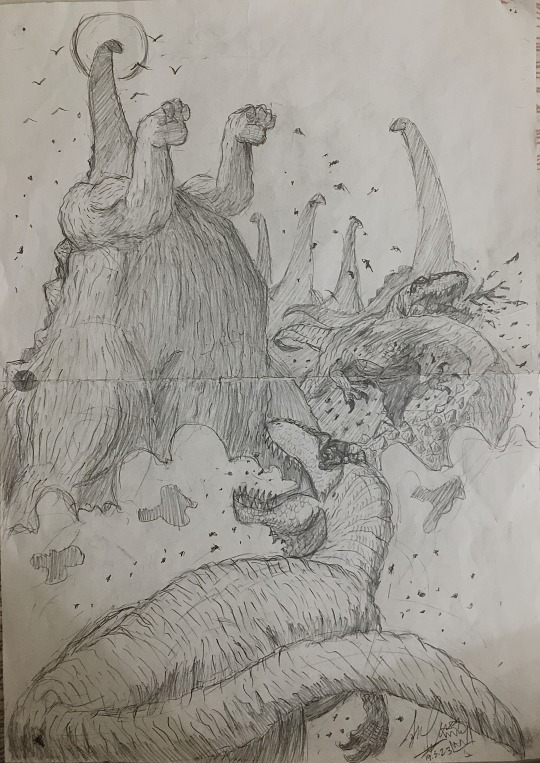
Smite from above
I didn’t have access to my tablet this time which means no digital art atm but I did manage to crank one out on paper this time =>
This is an idea I’ve had for quite some time but I’ve had no success actually putting it on paper before but I think I did it this time! Quite proud of it if I do say so myself~
#dinosaurs#patagotitan#giganotosaurus#paleoart#paleontology#candeleros formation#dinosaur art#jurassic park#drawing#traditional drawing#traditional art#I have no idea if titanosaurs could rear up like this#Probably not but shhhh I needed something dramatic looking ;)
64 notes
·
View notes
Text
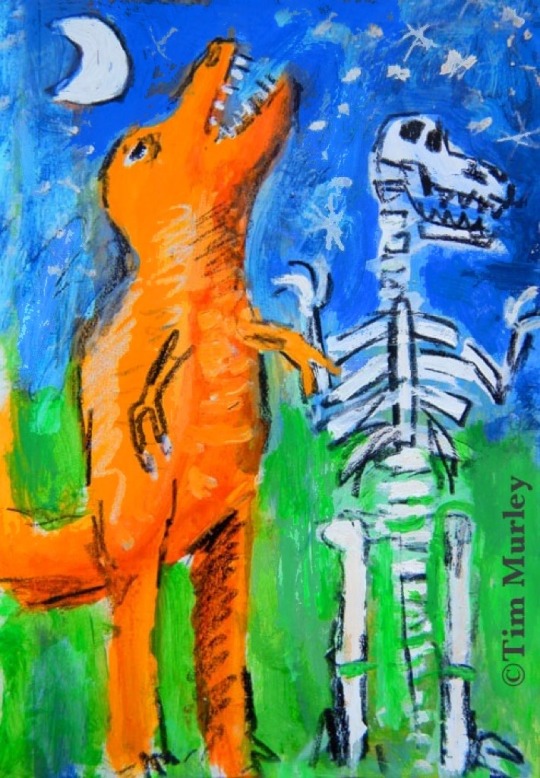
Fading into dust. 🦖🌋
#dinosaurs#dinosaur art#dinosaur#dinosaurios#dino sour cookie#tyrannosaurus#tyrannosaurus rex#t rex#spinosaurus#brontosaurus#skeleton#hell creek formation#paleontology#jurassic june#jurassic world#jurassic park#jurassic park 30th anniversary#jurassic period#jurassic series#jurassic coast#fossils#basquiat#jean michel basquiat#naive art#folk art#folk art painting#kids room decor#triceratops#pterodactyl#velociraptor
52 notes
·
View notes
Text

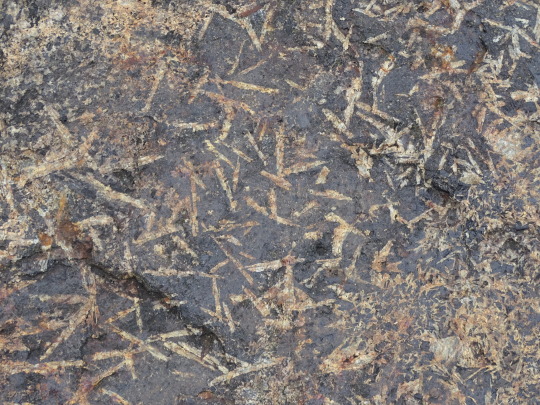

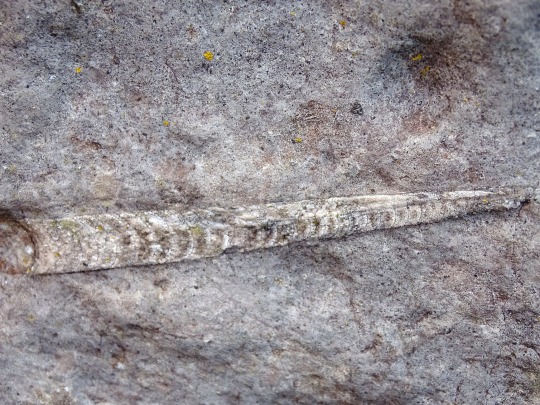
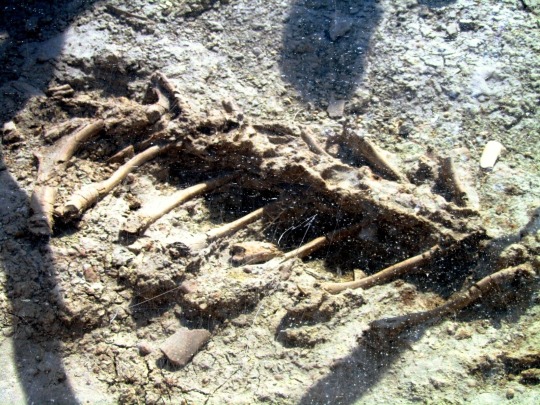
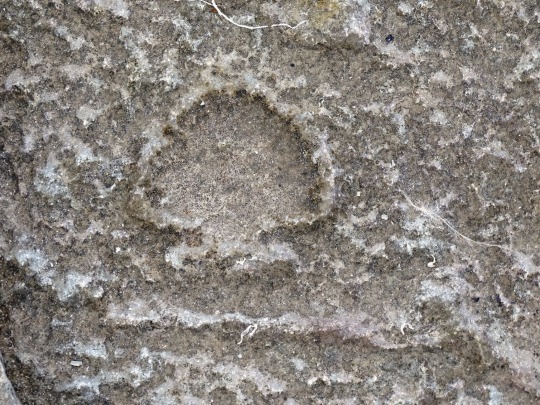

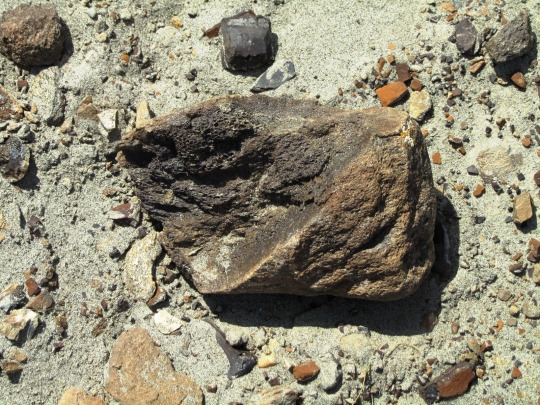

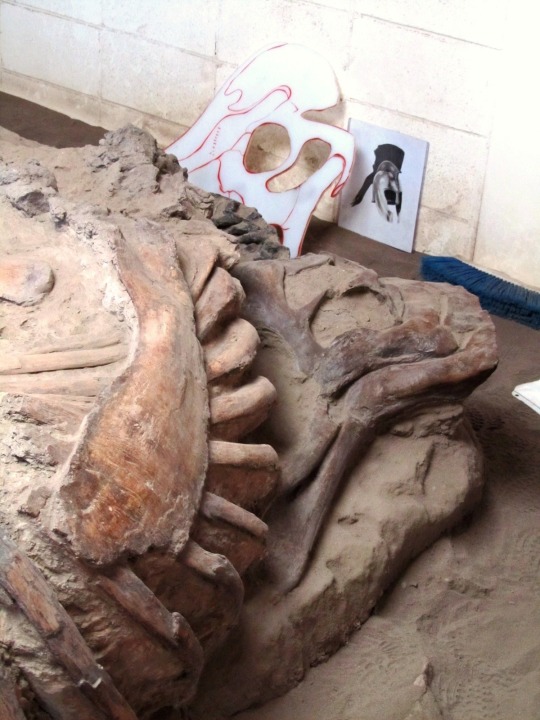
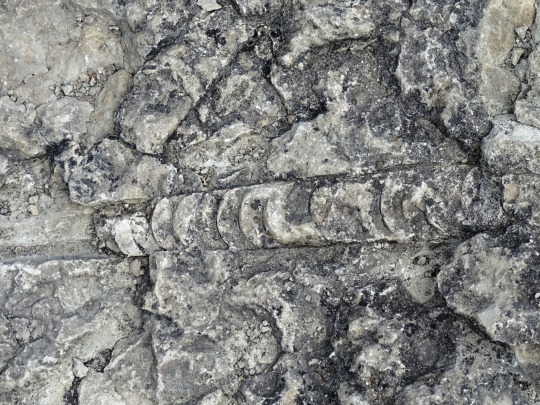

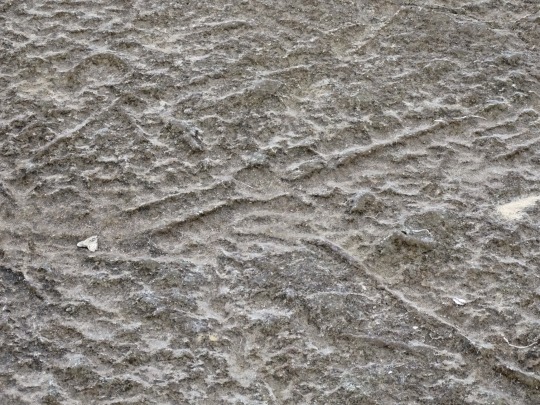

National Fossil Day
Fossils aren’t just interesting and fun to look at — they’re also proof of the existence of once-living things (like dinosaurs, animals, plants and even DNA remnants). Through these fossils we’re able to learn a lot about life from billions of years ago. We can even take a look at animals and life-forms that are no longer on the planet! These fossils (and the education around them) deserve to be preserved and explored. That’s why we celebrate National Fossil Day annually on the Wednesday of the second full week in October, with this year’s celebration being held on October 16. Show some appreciation for these incredible “time capsules” and the paleontologists who excavate them.
National Fossil Day timeline
1840s - 1850s Researchers discovered the Neanderthal
Ancient human fossils were unearthed for the first time, proving the existence of the Neanderthal.
1902 Proof of T-Rex
Researchers uncovered the first Tyrannosaurus Rex remains.
1974 Lucy was born
Scientists found fossils of a 3.5 million-year-old female hominin (an extinct human species) and named her “Lucy.”
How to Observe National Fossil Day
Hug a paleontologist
Check out local events
Visit Your Nearest National Park
Paleontologists are pretty incredible people. They go through lots of schooling and training to be able to study the fossils of all kinds of organisms. It’s because of them that we know a lot about the last few billion years of our planet’s history. Show your appreciation by giving them a hug, and asking them to tell you more!
Every year, the National Park Service partners with various organizations, universities, museums and more to celebrate National Fossil Day. Through field trips, classroom instruction and outdoor activities, they’re spreading awareness about this important holiday.
Many national parks are passionate about introducing future generations to the science behind fossils and paleontology. These may include anything from scavenger hunts, to multi-day ranger-led activities. Visit your nearest national park and discover all there is to know about this fascinating science!
4 Fun Fossil Facts
They’re insanely valuable
They can be enormous
Anything can be fossilized
They’re ridiculously old
The highest amount ever paid for a dinosaur fossil was $8.3 million (they named it “Sue”).
The largest intact fossil ever discovered was a whopping 4 square miles!
The smallest fossil on record was just 2/10 of a millimeter (it was of a 50-million-year-old parasite).
Next time you're feeling old, just remember some fossils date back to 4.1 billion years.
Why National Fossil Day is Important
We can learn about our planet
We can understand the progression of time
We can look toward the future
A fossil is evidence of past life that’s been preserved in rock. This helps us discover all kinds of shells, plants, animals, and more that existed long before our time. This information helps us understand what was happening during each part of our planet’s history.
By looking at fossils, researchers have been able to understand how and when organisms appeared and disappeared throughout the passage of time. This is how they’ve been able to divide up the events in our planet’s history into different periods.
Each fossil tells a story of the organism it encapsulates, and the details of when it was on the earth. By examining fossils, we can use these stories to help inform us about the future, and how environmental factors (as well as man-made ones) will help influence our planet for future generations.
Source
#National Fossil Day#Wednesday of the second full week in October#Sweden#travel#NationalFossilDay#Byrums raukar#Öland#summer 2020#2012#Alberta#Neptuni Åkrar#Neptune's fields#Corythosaurus#bone#Canada#Dinosaur Provincial Park#UNESCO World Heritage Site#indoors#outdoors#Baltic Sea#nature#rock formation#original photography#16 October 2023#Byrums Raukar#Rotsidan#Ortho Ceratite#Orthoceras#geology#tourist attraction
4 notes
·
View notes
Text
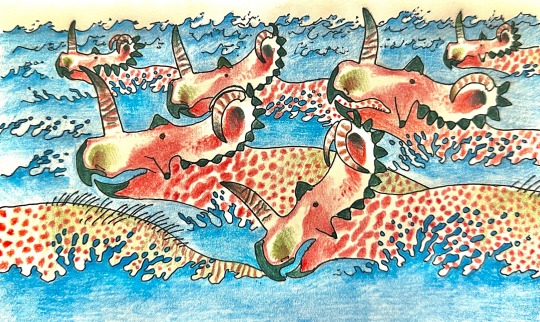
Dinovember 2024 Day 11: The Ancient Herds
A scene inspired by the bonebed finds of the Dinosaur Park Formation of Alberta, Canada - As the dry season hits hard, a herd of Centrosaurus apertus daringly cross a river in order to reach a pasture of green ferns on the other side, and only a lucky few of these ornately-horned ceratopsians will succeed in completing this arduous task.
#paleoart#dinosaur#dinosaurs#paleontology#ceratopsians#ceratopsian#centrosaurus#dinosaur art#dinovember 2024#dinovember#dinosaur park formation#campanian#late cretaceous#cretaceous period#paleobiology#paleoblr#palaeoblr
514 notes
·
View notes
Text
Why does this sound like what Ian Malcolm says when he first sees the stegosaurus in the Jurassic Park novel LOLOLOL
(it’s the scene with the triceratops in the movie, for context)
He says something like “I have to admit, that’s a funny looking animal” but seems to mean it in a slightly more positive way than this article.
In all fairness, I love the stegosaurus and think it’s got a pretty bizarre look (I think that’s part of its ✨charm✨). Apparently Edwardian news would disagree lol

The Washington Post, June 23, 1912
#jurassic park#jurassic park book#always a quote adventure#I think this qualifies as a quote haha#jurassic park novel#always a learning adventure#ian malcolm#stegosaurus#stegosauria#dinosaurs#books#quotes#news#yesterday’s print#morrison formation
40K notes
·
View notes
Text
new favourite dinosaur and its a tyrannosaur. i am not immune to the propaganda.
#i dont know why but tyrannosaurs never really interested me before this#like. theyre cool but idk#theyre so overhyped. its not their fault#anyway its nanuqsaurus. a kind of tyrannosaur that lived towards the end of the cretaceous in the prince creek formation#which is located in modern day alaska pretty close to the most north you can get in that state#tyrannosaurs have one really cool thing going for them and thats their binocular vision#most dinosaurs didnt have forward facing eyes from what we know but those guys did#i guess theres also the biggest known predator ever (that we know of) by mass thing but i think the binocular vision is a bit cooler#it gives them this almost mammalian vibe to me and i appreciate the uncanny-ness#so yeah if jurrassic park happens dont stand still. it will see you perfectly fine
0 notes
Text

A Chasmosaurus belli wades into a shallow stream while a herd of Stegoceras relax under a blooming magnolia.
This piece was one I cranked out really quick one evening because a friend was having a weird day. Not a bad day, but not a good day. They sent me a snap of the spot they decided to have a sit for a while and to lighten their mood I produced the above image by dropping some dinosaurs into their sitting spot. Since I usually take a long time to produce any single image I cut a few corners on this, primarily everything still has my dark and sketchy initial linework still on it rather than a clean and smooth job. The choice of Chasmosaurus relates back to a small plastic dinosaur and a goofy interaction we had over it, but the composition is modified from an old pen-and-ink doodle I made at my old factory job while I was waiting for my machine to finish cycling (I doodled a lot while I worked there, cycle times took forever).

#digital art#krita#dinosaurs#ceratopsian#chasmosaurus#stegoceras#dinosaur park formation#magnolia#a nice place to sit#pen and ink
4 notes
·
View notes
Text
It's National Dinosaur Day in Australia!
The 7th of May is officially National Dinosaur Day! While our fossil record might be a bit patchier than some continents, there are still plenty of excellent dinosaurs that have been found from the Mesozoic and Cenozoic, and here's a few of them!
Australovenator wintonensis

(art by Scott Reid)
Probably the most iconic Australian dinosaur, Australovenator was a large theropod with massive hooked hand claws from the Winton Formation. It was the first megaraptoran identified in Australia, a group of theropods that we now know were widespread and successful across the southern hemisphere in the Cretaceous!
Kunbarrasaurus ieversi


(art by Ashley Patch)
One of the few armoured dinosaurs found in Australia, Kunbarrasaurus ieversi is known from a beautiful full-body fossil from the Allaru Formation that preserves the armour plates in their life positions!
Dromornis stirtoni

(art by @knuppitalism-with-ue)
The Dromornithidae (also known as mihirungs) have a roughly emu-like body plan but are actually a member of the group Anseriformes, closer to waterfowl! Dromornis stirtoni from the Alcoota Fossil Beds is the largest bird to ever live in Australia that we know of, weighing around half a ton.
Genyornis newtoni
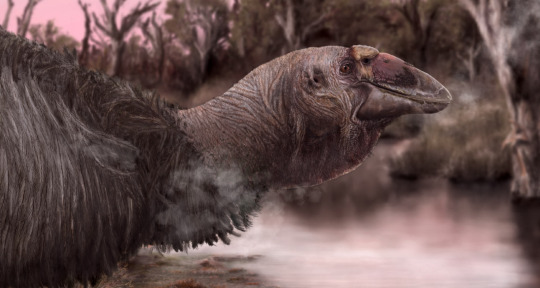
(art by Jacob Blokland)
The latest-surviving mihirung, Genyornis was described in 1896 but the first well-preserved skull fossil of this quarter-ton bird was only published last year by Phoebe McInerney, who I actually know! I also got to do a little bit of work on the second skull of Genyornis in the lab earlier this year so it's not only a cool animal but one I'm especially personally fond of!
Fostoria dhimbangunmal

(art by James Kuether)
Fostoria is a mid-sized iguanodontian that's known from Australia's only ornithischian bone bed, an extremely rare find for a continent whose Mesozoic dinosaur fossils tend to be pretty badly scattered and fragmented. The bones of multiple individuals were found together in the opal fields of the Griman Creek Formation, and the bones themselves had been opalised!
Australotitan cooperensis

(art by Vlad Konstantinov)
Known simply as Cooper for 15 years, Australotitan finally got a full description in 2021 which marked it out as not only Australia's biggest dinosaur but on the scale of some of the largest known sauropods in the world!
Anthropodyptes gilli

(art by,,, Travis Park? I think? this one was a Struggle)
Today the only penguin native to the mainland is the little blue penguin, but in prehistory there were much larger penguins around! They're only known from fragmentary remains in Australia, but species like Anthropodyptes gilli and Pachydyptes simpsoni grew larger than modern emperor penguins!
Diluvicursor pickeringi

(art by Peter Trusler)
One dinosaur we seem to have heaps of in Australia (as with the rest of the world) is small ornithischians. These sprinty little guys are almost ubiquitous in Mesozoic ecosystems, and in Australia Diluvicursor is one of the more complete examples, with a holotype fossil from the Eumeralla Formation that preserves the tail and foot bones.
Phoenicopteridae (Flamingos)
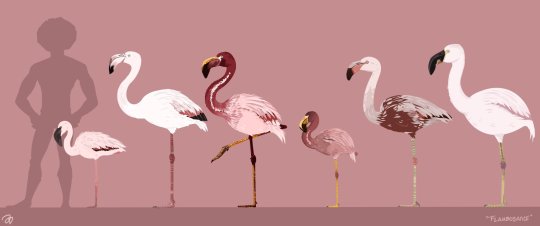
(art by Astrapionte, featuring from left to right: Phoeniconaias proeses, Phoenicopterus copei, Xenorhynchopsis tibialis and minor, Phoenicopterus novaehollandiae, and Phoeniconotius eyrensis)
Last fun fact about Australia, did you know we used to have flamingos until very recently? The flamingo fossil record in Australia is pretty limited, but we know they lived here from the Oligocene all the way to the Pleistocene, when they were likely wiped out by environmental change as the centre of the continent dried up. Phoeniconotius eyrensis seems to have been one of the largest flamingo species, likely heavier than the modern greater flamingo!
365 notes
·
View notes
Note
Very sorry if you've talked about this before, but how much do you focus on/care about making the plantlife in your Dinosaur Project Thingy accurate for the time and place?
Asking both because I'm generally very curious, and because personally, every time I make it past my anxieties about not knowing enough about dinosaurs to be "allowed" to draw them, I run right up against "oh shoot, if I draw a grass in the background, people are going to kill me."
Having a cartoonier art style helps! If your style is photorealistic, the style is going to require more details that also make errors way more present and visible, but like, the way I draw trees for example you can't really tell if I'm drawing an aspen, an oak or a basswood, you know? It's just a leaf blob with a trunk in the middle. There's no identifying that.
Also, like 99% of my audience who follows my art follows it for creatures and characters, not plant life, and those more well versed on plants aren't as likely to care. At least nobody has come to bark at me because of it this far!
Considering the amount of actual, professional palaeoartists who basically use memes in their art, I think it's okay and fine for hobbyists and cartoonists to not know everything, right?
(Seriously, the amount of artists who draw theropods with no soft tissue around the jawline is wild! You know that classic look where the entire face splits along the skull all the way to the back of the jaw joint, and drawing that pink skin flap at the corner of the mouth? That's the jaw muscles. Why would a giant land apex predator not have skin protecting its jaw muscles? [Also, is that really what jaw muscles look like? A skin flap? Come on.] I've seen some Actual Professional Artists draw these giant cavities inside the cheek area of things like T. rex, that's where the muscles should be! Where do you think the legendary bite force -which this specific animal is known for- comes from? I mean, it works for animatronics, like in Jurassic Park, because it's hard to give soft tissue to robots that would hold up, but it's less of a thing for art, I think.)
I have a field guide book for Hell Creek formation that I'm gonna reference from when needed. Years ago I backed this kickstarter for a dinosaur video game, specifically so that I could get my hands on the book for this exact reason. It has plants section!
Few rules of thumb:
Trees Big. No, bigger!
No grass (if very late Cretaceous, then maybe grass? but research first!)
No flowers, unless Cretaceous. Might be worth googling "Cretaceous flowers" for specifics
When in doubt, ferns and/or conifers.
Also, finally, this is just me, but it can help to set yourself a "target audience" (with quotes). Personally, I'm making my project for myself and maybe a handful of people I know IRL. I only aim for the joy of these specific bunch of friends and family. Anyone beyond that is just bonus, and while I am very glad there are great many more people who do enjoy my work, it's less important than if my friends like it. And if there's one of the extra bonus people who thinks this one plant on the background of my art ruins their enjoyment of my work and me as a person, then that's a them-problem, not a me-problem, if my friend Satu still thinks the drawing is cool.
(Honestly, knowing these specific people, I wouldn't even have to be as accurate as I am, but unfortunately I did include "myself" in my target audience, so here I am.)
168 notes
·
View notes